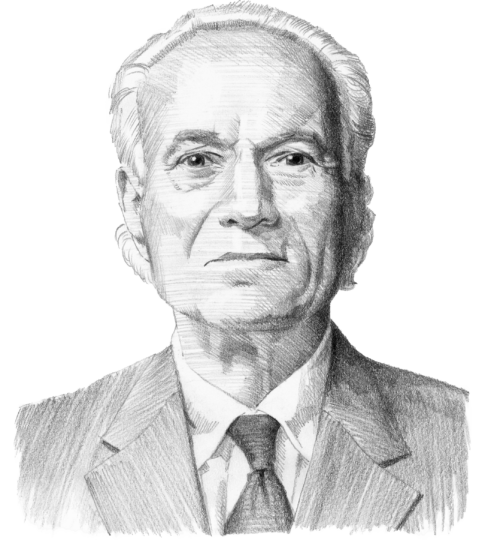Peru’s president bets on fighting corruption
Peruvians will vote in a December referendum that could introduce anti-corruption rules giving President Martin Vizcarra a more powerful hand as he faces a hostile congress. If the referendum fails, however, the country’s new leader would be weakened, prolonging political dysfunction and holding the economy of Peru back.
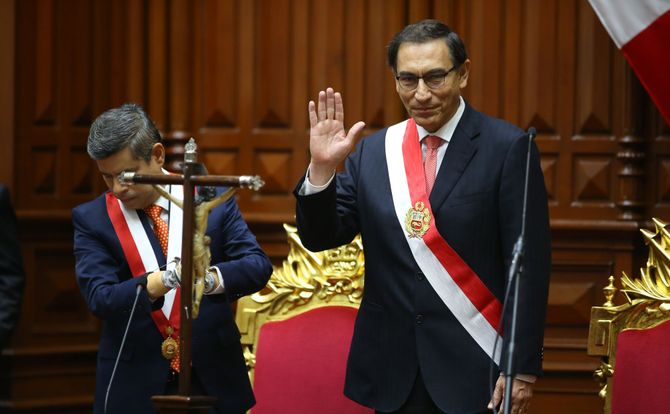
In a nutshell
- Martin Vizcarra has put fighting corruption at the center of his agenda
- He faces a hostile congress that could scupper his plans
- More political instability will hamper Peru’s economy
Peru’s politics have been in disarray for several years. Corruption scandals have ensnared three Peruvian presidents, several members of congress and more than a dozen judges. In March 2018, President Pedro Pablo Kuczynski (PPK) resigned to avoid impeachment over a conflict-of-interest scandal that included alleged vote-buying.
Peru’s new president, Martin Vizcarra, had been elected first vice president as PPK’s running mate in the 2016 election. As president, he inherited difficult circumstances, particularly a hostile congress dominated by the conservative Popular Force (FP) party of Keiko Fujimori. Disenchantment with the government is growing, while the economy has slowed significantly over the past decade.
To make it through the end of his term in 2021 (he has declared he will not run in that year’s elections), President Vizcarra will have to overcome the FP’s grip on legislative power, restore faith in the country’s institutions and boost economic growth. Following a stream of recordings showing judges trading favors with businesspeople, other members of the judiciary and some FP lawmakers, Mr. Vizcarra has staked his presidency on fighting corruption. Key to his plan is a December referendum on several constitutional reforms. If the measures pass, President Vizcarra will gain political capital to pursue his agenda. If they fail, Peru will likely suffer more political instability and an economic slowdown in the coming years.
Compared to his predecessor, Mr. Vizcarra has maneuvered more effectively against a hostile congress.
Congressional reshuffling
Compared to his predecessor, Mr. Vizcarra has maneuvered more effectively against a hostile congress dominated by the FP. Ms. Fujimori’s father, Alberto, ruled Peru as an autocrat in the 1990s and remains a controversial figure. Imprisoned for human rights abuses, he was pardoned last year in a gamble by PPK to avoid impeachment. The move sparked anti-Fujimori protests across the country.
Early in his presidency, Mr. Vizcarra persuaded congress and the FP to delegate legislative power to the executive for 60 days, enabling him to pass mandatory conflict-of-interest disclosure rules for public servants. His economic policy is focused on improving tax collection, something he has so far been unable to achieve. His proposal to increase the value added tax (VAT) was poorly received, and Ms. Fujimori’s party quickly exploited its congressional dominance to force the resignation of Economy and Finance Minister David Tuesta.
Facts & figures
Changes in the composition of the Peruvian Congress
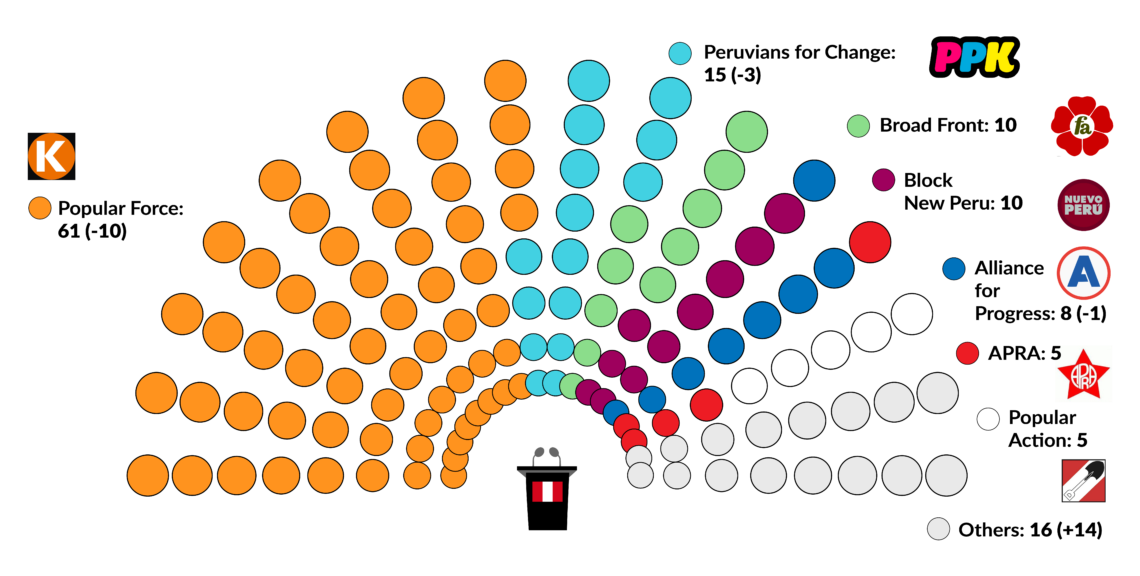
However, President Vizcarra has been swift to mobilize disparate elements of the emerging anti-Fujimori movement. He is an independent, but his predecessor’s Peruanos Por el Kambio (PPK) party, which supports the Vizcarra government, holds only 12 percent of the seats in congress. He has also benefited from Ms. Fujimori’s public feud with her brother’s faction of the FP, splitting her party and depriving it of its majority in congress (from 57 percent of seats in 2017 to 49 percent in 2018).
In July, the president proposed a referendum on four constitutional reforms to push through stalled anti-corruption measures. When congress hesitated, he threatened to make the reforms an issue of confidence in his cabinet. Last year congress censured Mr. Kuczynski’s cabinet; censuring Mr. Vizcarra’s would allow him to call fresh parliamentary elections, a risky proposition for FP.
Moving against corruption
The gamble paid off and the proposal was approved – the referendum is now scheduled for December 9. For Mr. Vizcarra, the reforms are an opportunity to distance himself from his disgraced predecessor and the ongoing corruption scandals, as well as to bolster public support for his agenda. From there, President Vizcarra plans gradually to build popular support for further reforms in rural education, women’s rights, political decentralization and stimulating the economy through public works projects.
The political reforms on the ballot in the referendum include reestablishing the Senate, limiting legislators to a single consecutive term, establishing a new board to select and supervise judges and prosecutors, as well as establishing audits for political parties’ finances and introducing penalties for illegal donations. These proposals are not new, and some are designed to evoke popular support. For example, the limit of one consecutive term for legislators is primarily seen as a proposal to exploit the low public opinion of congress – its approval ratings are now close to single digits.
Facts & figures
President Martin Vizcarra's approval
Aug.-Oct. 2018
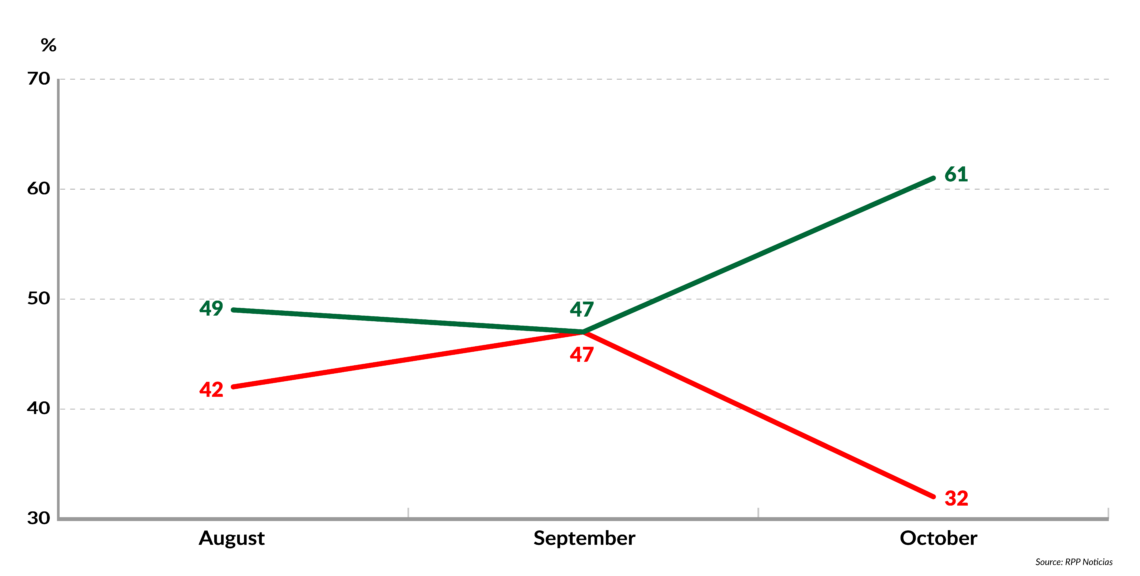
The approaching referendum has been a boon for President Vizcarra, whose approval rating rose 14 percentage points to 61 percent in October. Earlier in the month, police arrested Ms. Fujimori and some of her closest allies in connection to the same Odebrecht scandal that forced PPK’s resignation at the start of the year. Although she denies all allegations, these events give the president’s reforms additional impetus. In another high-profile case, a justice of the Supreme Court of Peru, Cesar Hinostroza, tried to avoid prosecution for corruption by fleeing to Spain. Interpol and the Spanish government have promised to send him back to Peru for trial. All this gives President Vizcarra an opportunity to promote his agenda, especially as the FP appears to be imploding with breathtaking speed. If the FP falls apart, the president’s path becomes easier to navigate.
Accelerating the economy
During the previous decade, favorable prices for Peru’s main exports – copper, gold, zinc, iron and coffee – made it one of the fastest-growing economies in the region: in 2010 its gross domestic product (GDP) expanded by 9.1 percent. Despite the political turmoil in recent years, the country has continued to grow, albeit far more slowly. Peru’s decentralized economic system partially shielded regions from the uncertainty in the central government, enabling continued investment in extractive industries. Recently, the economy has accelerated: GDP is expected to grow by 3.2 percent this year, a significant uptick from the 2.5 percent recorded in 2017. While not close to the rates achieved during the commodities boom, it is still well above the average for the region.
Like most of Latin America, Peru has become dependent on China as a trading partner. Even with the Chinese economy’s slowdown and the decline in commodity prices over the past few years, China remains Peru’s leading trading partner, accounting for 36 percent of the country’s exports. The U.S. is next, though far behind, at 11 percent. The Pacific Alliance (comprising Peru, Chile, Colombia and Mexico), which is still in its early stages of development, should boost the flow of trade with Chile and Colombia over the next few years.
Facts & figures
GDP growth and net export prices
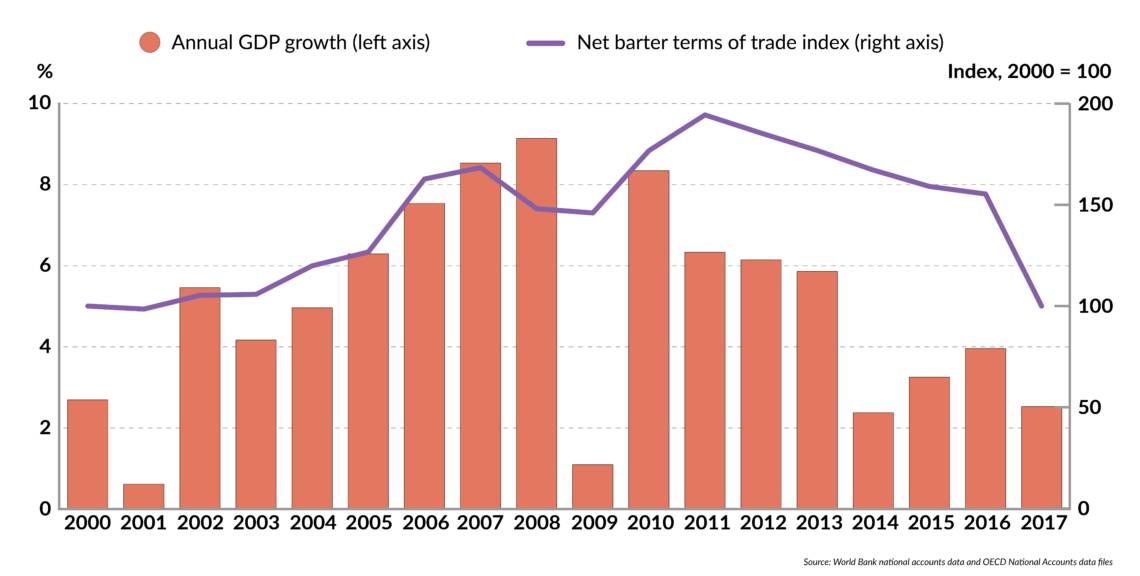
Economists attribute Peru’s economic recovery to low inflation (0.4 percent in the second quarter of 2018), increased private investment, household spending and the modest reactivation of public investment. Rising prices for copper and other minerals have buoyed mining investments in Peru, which have been growing since late 2017 (12.3 percent) after severe falls in 2016 (-50.8 percent) and 2015 (-11.2 percent). The government estimates that new mining projects could bring in up to $59 billion in investment.
However, some of these projects will face significant opposition from community groups concerned about the mines’ environmental impact and lack of local hiring. In the past, some anti-mining protests have turned violent, causing project delays and increasing costs. Nonetheless, mining opportunities in Peru continue to attract significant international investment. According to the Fraser Institute, the country is second in the world in the value of exploration-oriented investments, behind Canada. Recent studies have revealed significant reserves of lithium in the border region with Bolivia, which may provide an opportunity to reduce dependence on copper exports in the longer term.
Meanwhile, agricultural output has rebounded following the disruption caused by the El Niño weather pattern at the start of 2017. Construction has also been a growth sector in recent years and could benefit from President Vizcarra’s plans for large public infrastructure projects (electrification, roads and housing) as well as private investments in retail and industrial clusters, natural gas pipelines and refining operations.
The Odebrecht corruption scandal has limited desire for investment in large infrastructure projects.
Yet problems remain. Externally, protectionist policies and higher interest rates in the U.S. may limit capital flows into Peru. Internally, continued political turmoil could sap risk appetite and business confidence, especially if the December referendum fails. For the time being, the visibility of the Odebrecht corruption scandal has limited desire for investment in the large infrastructure projects that typically drive public spending. Peru also faces challenges in attracting non-mining investment, primarily in tourism.
Rural education
While previous administrations have historically catered to the needs of Peru’s main cities at the expense of rural regions, President Vizcarra has signaled he will seek to aggressively reduce rural-urban educational attainment gaps. Peru has one of the lowest educational achievement scores on the OECD’s PISA tests (ranking 64th out of 73 countries), largely due to lower results in rural parts of the country. By 2021, the government aims to improve scores in rural areas from 46 percent to 55 percent in reading comprehension and 34 percent to 45 percent in math. It is investing in improving resources and teaching programs for these regions.
Education reform has not been without its challenges. In June, teachers’ unions held a national strike demanding greater investment in education, salary increases and the suspension of teacher performance evaluations. While the strike was small compared to the those that paralyzed parts of the country in 2017, it did have a big impact on some rural states such as Puno, which are focus areas for the president’s education plan. Partially as a result of these disturbances, Mr. Vizcarra announced national increases in teachers’ base salaries and compensation to take effect in 2019.
Scenarios
The most likely scenario is that the referendum measures supported by President Vizcarra will pass. A recent poll indicated that two-thirds of Peruvians are in favor of these reforms. This success would give President Vizcarra the legitimacy he needs to govern for the rest of his term. With Ms. Fujimori currently in jail and the spotlight on her potential dealings with Odebrecht, the FP party is unlikely to put up much resistance to the president’s agenda.
The biggest challenge for the government under this scenario would be to deliver on its reforms to meet newly established expectations. It will need to move quickly to channel stalled public investment. After the El Niño destroyed key infrastructure in 2017, reconstruction has been slow due to political instability and increased scrutiny of public contracts. A continued delay in reconstruction would erode the public support Mr. Vizcarra has recently gained.
The U.S.-China trade dispute also poses a significant risk. The tensions caused the price of copper to fall in mid-2018. Moreover, a slowdown in U.S. and Chinese markets could have a negative effect on the country’s growth.
The much less likely scenario is that the referendum fails, putting the government in jeopardy. If this happens, Mr. Vizcarra could try to bolster his position by once again invoking a vote of confidence on his cabinet and risking fresh elections.
More political instability would shake the consumer confidence that has so far helped buoy the economy. The services sector has experienced healthy growth since Mr. Vizcarra’s referendum announcement, with the financial sector on track for 6.3 percent year-on-year growth. Other services, such as telecommunications and hospitality, could also be hurt if the referendum is blocked. In this scenario, political instability in Peru would continue, and its economy would slide into stagnation.
